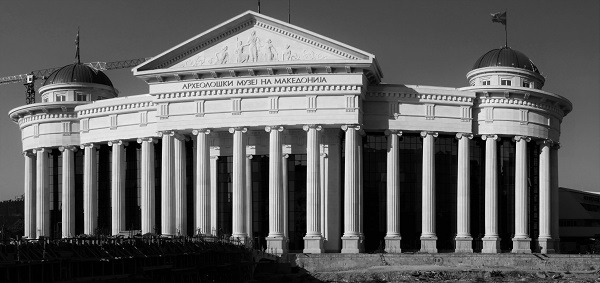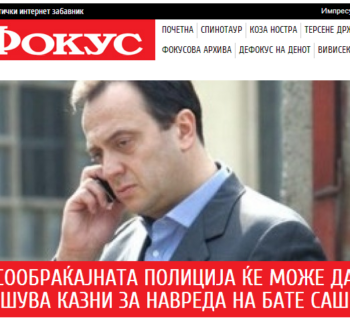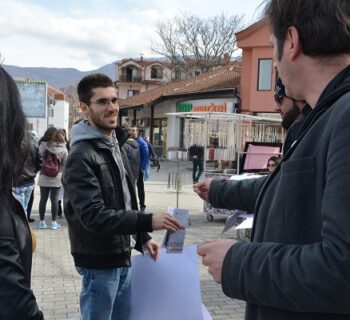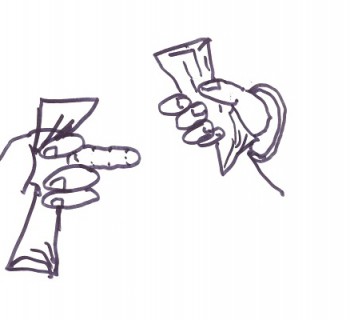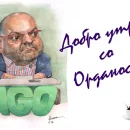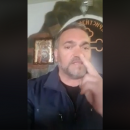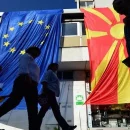Danica Pavlovska, architect and spatial planning expert, spoke to CIVIL Media about the “esthetics” of the “Skopje 2014” project, as “an ugly postcard” that can leave the citizen indifferent. Starting from the thesis that resources and funds, which Macedonia doesn’t have, are being spent for “Skopje 2014”, Pavlovska believes that those who imagined and implemented this project should be called upon and punished, and that, unfortunately, “our people accept living with that quasi-esthetics as something that is necessary!”
CIVIL Media: What is your position on the “Skopje 2014” project?
PAVLOVSKA: In a short description – it is a crazy performance! It is so absurd that it is difficult to understand, not only because it lacks its essence that should be interpreted, but also because its appearance in the past seven years has become so uninteresting that the citizen for which the project should exist, is becoming unresponsive. This means that the citizen does not have to dislike it, but that the citizen cannot even hate it! Our people have come to accept living with that quasi-esthetics as something that is necessary. I hope that the citizen will try to change that. Naturally, the expertise has been avoided in this entire story, and I as a representative of the architects, really hope that tomorrow we will be heard. “Skopje 2014” has no geographical, time or economic context… no cultural, nor sociological, it is simply an attempt to change the identity of the Macedonian people, because it has the pretensions of sending out such a message, but it is not at all accepted in that sense. It is silly to erase history and rewrite another one! And it is also not responsible. That is why I think that those who did all of that should be called upon and punished.
For me, the consequences are worst in the cultural sense. There is a strange message, but an even stranger appearance, and the strangest in that respect is the impact it has on our people, in the cultural sense. One cannot accept this imposed esthetics. It is a misfortune, and I can see that it is being offered to the new generations as something they need to learn and accept as a criterion. That must not happen! Surely, I think of the future of our people, but I also think of the constructions. They have to undergo a re-architecture, although I do not call such a thing architecture. It’s matter, but in the skilled hands and thought out minds something savingly will be found within this process, which is still ongoing and is leading us day by day to a new cultural shock. I don’t even want to mention things like the Panoramic Ferris wheel or some kind of memorial statue of Mother Teresa, which is not what it is, or the things that have recently been splattered in an ugly postcard for Skopje.
CIVIL Media: How was “Skopje 2014” being built? How did institutions, ministries, museums and so on, later move into that “plethora” of new monuments, bridges, memorials and buildings?
PAVLOVSKA: In our profession, mixing functional contents is something that has to have a logical sequence. What has been done with the project is absolutely illogical. Mostly for those using the space, meaning, both for the buildings and their surrounding it is clear that there are incompatible contents in one single area, and that they can hardly function. That is why urban plans exist, to detail everything out, and that is why appropriate urban planning documents should have been made during the procedure, while the decision was being made, and not later, without any knowledge at all. Those random decisions in terms of the structures, their location, shape and even their contents have created a total mix-up.
CIVIL Media: How much will the citizen further decide on what is to happen with “Skopje 2014”, and how much will the experts be consulted?
PAVLOVSKA: Our public, the general and expert public, lacks a critical mass for raising such big issues. Even the civil society sector, where I am an activist, with everything we are doing as a process to protect GTC (City shopping center). “I love GTC” was a movement for protection of the complex that has universal values, which was also fading in the perception of our citizen. That apathy includes not only the professional tiers, but also the ordinary citizen who cannot stand the weakness. The real power is in the hands of the citizen, it’s just that there has to be higher awareness for that. The weakness stems from the regime in power. The regime is changing and should change. That is why it’s good for the citizens to know that the next political decision-making, in regards to everything that is in their interest, is in their hands, and especially in regards to public space. In that sense, I expect for the citizen to be more aggressive, thoughtful, in-depth…It would be good to read, to recognize the intentions of the politicians that are trying to win power and are offering some kind of projects.
Our legal system, on the other hand, is not perfect and it is yet to mature in order to follow the democratic processes in this region. This little country of ours is young as it is new, and in that sense, destruction is much more terrifying. If we have managed to make some steps forward in the first ten years of this country’s existence, it is very painful to have to go backward in the following twenty years. It is especially difficult for us, for the generations who have put efforts into all of that, because the impression is that we are leaving the country to the younger generations in a miserable situation.
CIVIL Media: Is there a possibility for “Skopje 2014” to remain as a memory and legacy of this period? Will we be able to change something fundamentally and change the image of the city, or will it remain as a dark spot?
PAVLOVSKA: I, as someone who loves Skopje, believe that the city’s image will constantly be changing. This change is also destiny that is happening to us, and one that we will outlive depending on our relationship towards the city as a subject. And we will endure it in a manner in which, I hope, will be fairly decent and civilized. As the project was created without any analytics, without an appropriate vision and without promotion which is very important, I believe that the following steps should be at the level of assessing what needs to be removed, what is harming us, and what needs to remain. Certainly, there are some consequences that just cannot be fixed. That devastation of space, as we call it in our vocabulary, means – the space no longer has the references it bears, is not usable, and is most obvious in the regulation of the Vardar river, where new constructions have spurred that are also just as senseless.
They simply do not have to, and should not be in that place and as such. It’s difficult to say whether the regulation of Vardar River will be operational after this attack has been made with these structures. Scars will remain, with which Skopje will still remain nice to me.
CIVIL Media: Could nature do its work and create a clean space?
PAVLOVSKA: In terms of time, or ravages of time, yes – there is a possibility. Due to the materials with which they are built. I wonder about that term as well, because often we use the term scenography, which directly associates to a very poor quality of materials. They are expected to depreciate quickly, damaged or destroyed, requiring huge amount of funds for their maintenance. Every Styrofoam coating, set as they have been, will quickly depreciate. At the same time, it represents a very high fire risk. These materials are highly inflammable, and we as professionals, really do appeal that they are dangerous. There was a fire during one construction, and that should have suggested stopping the realization. My final thesis is a moratorium on the project “Skopje 2014!” And that means putting a stop, and let’s see what has been done and how it has been done until now, but not anymore. If it can be stopped, the act of reassessing is the simplest way, we will see what needs to be further done, but not to build anymore, not to invest anymore…that is the painful moment of our poor country. We do not have a budget to allow ourselves over 600 million euros for décor.
Biljana Jordanovska
Camera: Аtanas Petrovski
This post is also available in: AlbanianMacedonian
 Македонски
Македонски Shqip
Shqip English
English


